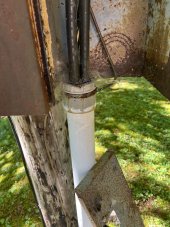@timselectric Finally got back to the cabin and was able to take these pictures. This connection here to neutral is why I thought this would be the first G/N bond in my system. No way to confirm if this copper wire is the same that connects in my panel (it does not run in the conduit with L1/L2/N) to house which is about 100 ft away. Anyway, based on what you said it's NOT the G/N bond but would like your input again.
I know this needs to get updated/replaced, but this is a pretty remote area. Five calls to electricians led to no where over 6 months outside of empty promise of showing up. Hope one day one will actually come out and look and do the ork
View attachment 105778View attachment 105779View attachment 105781





